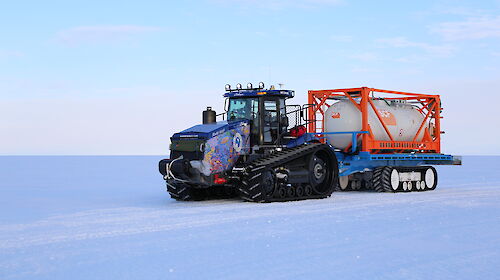Australia’s ground transport capability in Antarctica is set for a heavy-duty upgrade.
The Australian Antarctic Program has announced the first details of a new fleet of heavy tracked vehicles to support deep field operations, including the search for a million year ice core.
Project Lead, Anthony Hull, says the new traverse system will be able to meet Australia’s scientific and operational needs for the next two decades.
“This is a step-change in our ability to rapidly move large quantities of cargo and equipment deep inland in all weather conditions, and into areas that we can’t traditionally access by aircraft,” Mr Hull said.
“It allows us to deploy scientists and support teams to some of the most remote and extreme parts of the Antarctic ice sheet for extended periods of time.”
The new system will have five heavy tractors and two snow groomers which will tow sled trains carrying food supplies, accommodation, communal areas, scientific facilities, power generation and up to 160,000 litres of fuel.
The traverse will be managed by a team of eight expeditioners and have the ability to reach up to 1500 kilometres inland.
“The first expedition is planned to depart Australia’s Casey research station in early 2021 and set up a mobile research station 1200 kilometres inland at a location known as Dome C,” Mr Hull said.
“The station will be capable of supporting up to 16 people, flying in to undertake scientific research for up to three months.”
Australian Antarctic Division Glaciologist, Dr Tas van Ommen, said the new capability opens up the Antarctic interior to ambitious science projects, including the search for the Earth’s longest continuous ice core climate record.
“The million year ice core will be a window into a time when a major shift in the Earth’s climate system took place, and when the regular pacing ice ages gradually slowed,” Dr van Ommen said.
“We are working closely with our international collaborators to understand what caused this shift, because we believe it can help us better understand present day climate change.”
Scientists and engineers at the Australian Antarctic Division have also begun work on a new drill design for the project that is capable of extracting ice cores 3000 metres deep.
“Many of the components we need are specialist designs that have to be constructed and built in-house, and we have the right team to do that here in Hobart,” Dr van Ommen said.
“We are incorporating the latest technology that will allow us to recover the best quality core, to drill most efficiently, and hopefully get to the bottom of the ice sheet over a three-to-four year drilling period.”
The Australian Government committed $45 million in 2016 to re-establish overland traverse capability and drill for the million year ice core as part of the Australian Antarctic Strategy and 20 Year Action Plan.







